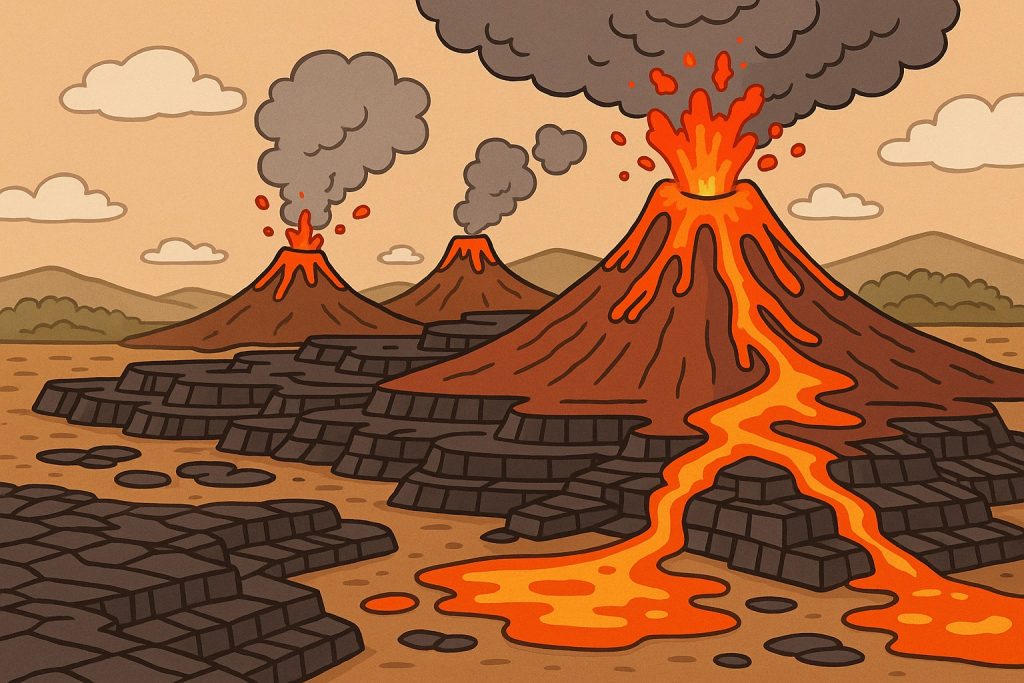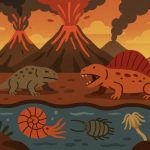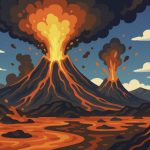The Siberian Traps are one of the largest and most powerful volcanic formations in Earth’s history. Located in present-day Siberia, Russia, this enormous volcanic region was the site of catastrophic basaltic lava eruptions around 252 million years ago — coinciding with the Permian-Triassic extinction event, the greatest mass extinction the planet has ever faced.
What Are the Siberian Traps?
The term “Traps” comes from the Swedish word trappa, meaning “stairs,” which reflects the step-like layers of solidified lava. The Siberian Traps Large Igneous Province (LIP) covers an area of about 2 million square kilometers, roughly the size of Western Europe.
The eruptions didn’t happen all at once — they occurred in waves over a period of nearly 1 million years. The region today consists of thick layers of flood basalts, some more than 4 km deep.
How Did They Form?
The formation of the Siberian Traps began with the rise of a mantle plume — an enormous, superheated column of rock rising from deep within the Earth’s mantle. As it neared the lithosphere (Earth’s crust), this plume began to melt the lower layers of rock, creating vast volumes of basaltic magma. Unlike explosive volcanoes with central cones, the Siberian eruptions occurred along massive fissures, or cracks in the crust, stretching for hundreds of kilometers. These eruptions released lava across huge plains in repeated pulses. The most intense phase likely lasted around 60,000 years, but the entire event unfolded over nearly a million years. This mantle plume event marked a moment when Earth’s internal heat escaped violently, forever changing the planet’s surface and atmosphere.
As the magma reached the surface, it spread out into flood basalts — extensive sheets of flowing lava that hardened into rock. These repeated eruptions formed layered basalt formations, known as “traps” (from the Swedish word trappa, meaning “stair”), due to their stepped appearance. There are hundreds of these layers, each ranging from a few meters to over 50 meters thick. In total, the lava deposits reached thicknesses of up to 4 kilometers, covering an area of more than 2 million square kilometers — about the size of Western Europe. The lava was rich in gases like carbon dioxide and sulfur dioxide, which were released into the atmosphere as the magma erupted. These emissions played a critical role in global environmental collapse. So the physical landscape we now call the Siberian Traps was built by successive outpourings of lava, freezing in place layer by layer during one of the most active volcanic episodes in Earth’s past.
Global Impact and the Permian Extinction
The timing of the Siberian Traps eruption is closely linked to the Permian-Triassic extinction (~252 million years ago). This event caused:
- 90–95% of marine species to go extinct
- Around 70% of terrestrial species to vanish
- Massive disruption to ecosystems and climates
Scientists believe the Siberian Traps were a major driver due to:
1. Climate Change
CO₂ and methane emissions led to intense global warming, acidified oceans, and weakened oxygen levels.
2. Ocean Anoxia
Nutrient runoff and warming triggered oxygen loss in oceans, creating “dead zones” where marine life could not survive.
3. Acid Rain and UV Radiation
Sulfur dioxide formed acid rain, damaging vegetation and ecosystems. Possible ozone depletion increased UV exposure.
Geological Legacy
Today, the Siberian Traps provide evidence for:
- How volcanism can alter planetary climate
- The role of large igneous provinces in mass extinctions
- The connection between Earth’s interior and surface life
They also serve as a cautionary tale about the long-term impacts of massive carbon emissions.
Glossary
- Basaltic lava — A type of molten rock that flows easily and forms dark, dense igneous rock.
- Large Igneous Province (LIP) — A vast region formed by massive volcanic eruptions over a short geological time.
- Mantle plume — A rising column of hot rock from Earth’s mantle that can cause volcanic eruptions.
- Anoxia — Lack of oxygen in a body of water, deadly for most marine organisms.
- Permian-Triassic extinction — The largest known extinction event in Earth’s history, ~252 million years ago.


